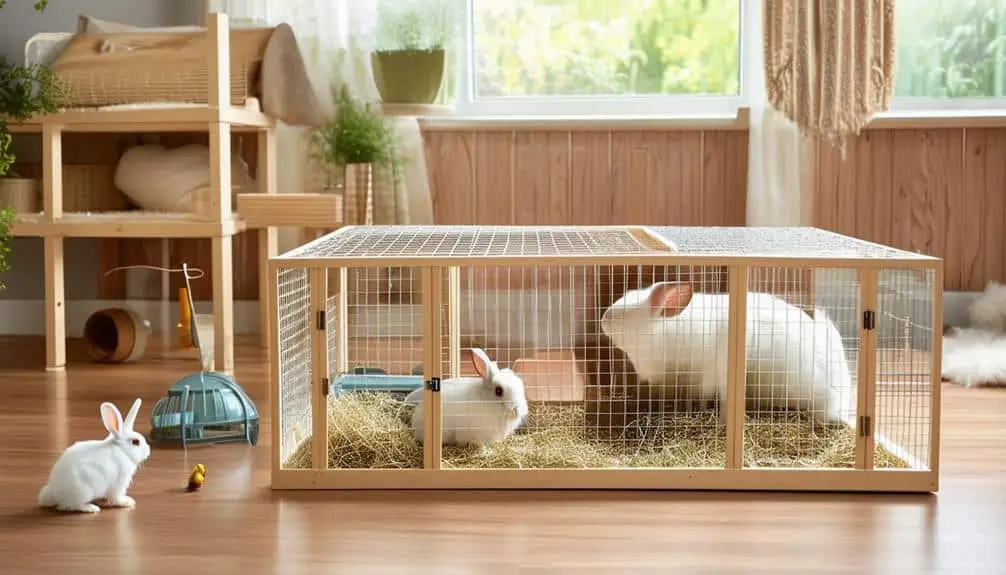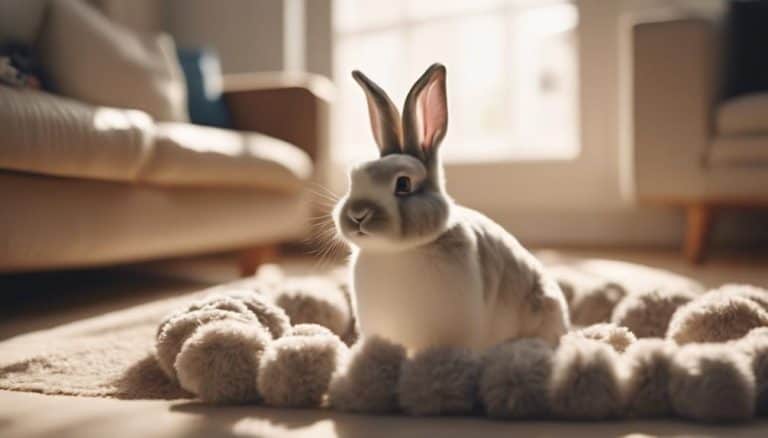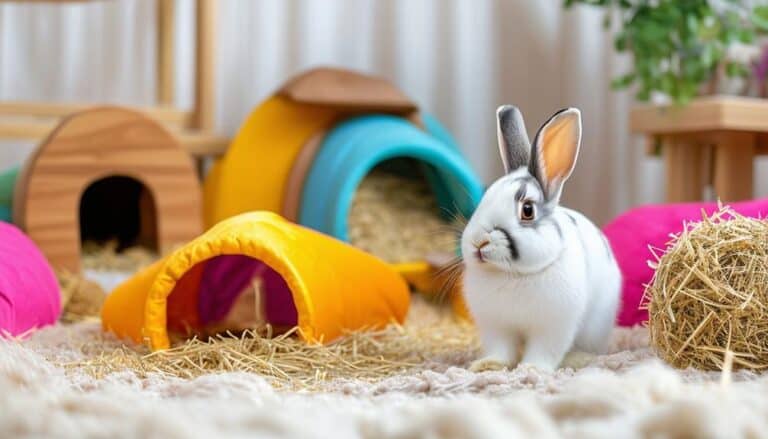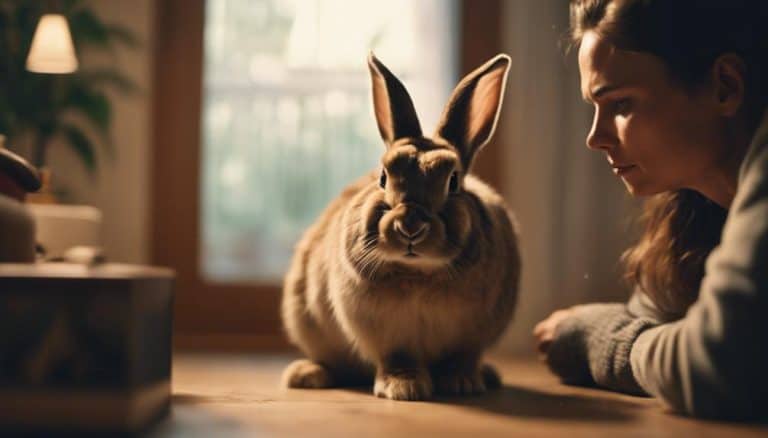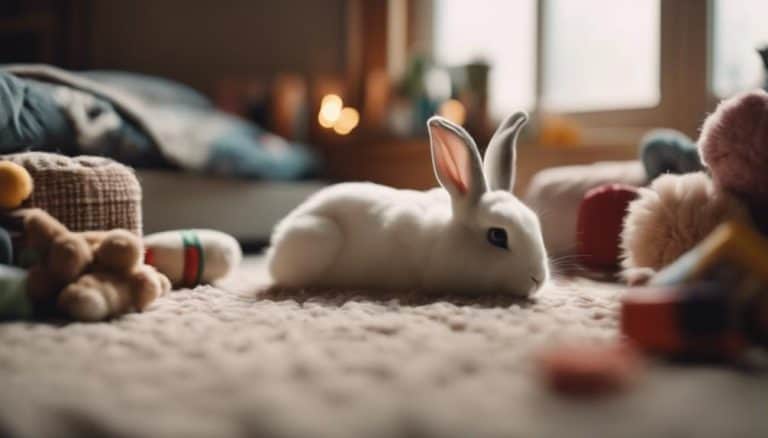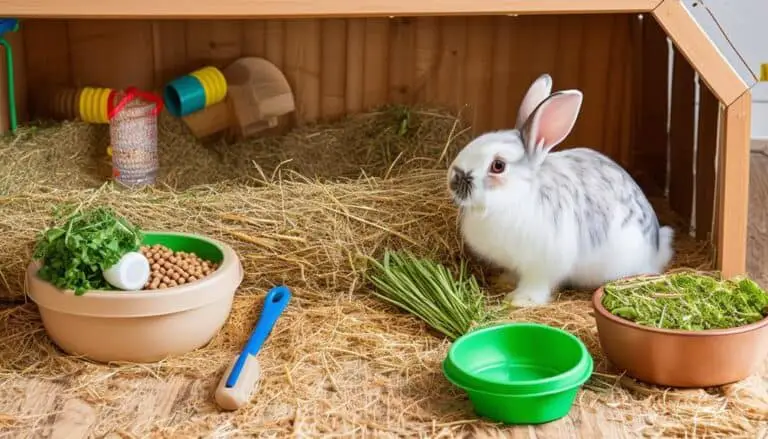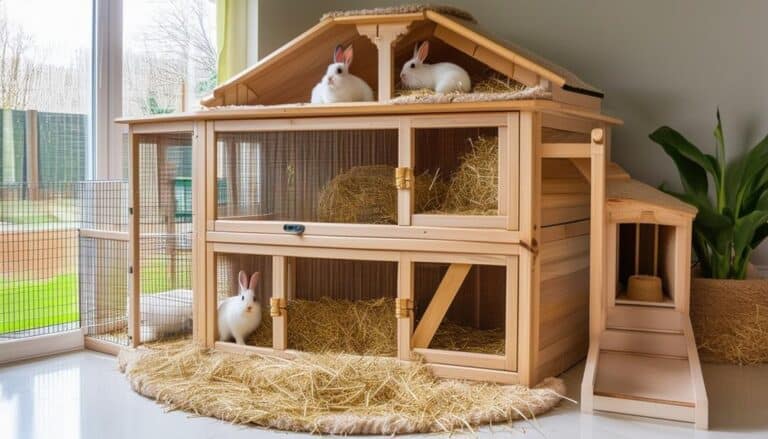7 Essential Must-Haves for Your Pet Rabbit
When caring for our pet rabbits, we must guarantee they have seven essential items. First, a spacious and secure housing environment with solid flooring and temperature control. Second, a nutritious diet of unlimited timothy hay, fresh vegetables, and moderated pellets.
Third, consistent access to clean water through a secure bottle. Fourth, a litter box with rabbit-safe litter and hay nearby. Fifth, diverse enrichment toys for mental stimulation and activity. Sixth, grooming tools like nail clippers and slicker brushes. Finally, a first aid kit for any emergencies.
Equip your rabbit with these essentials to promote their well-being and discover more insights.
Suitable Housing
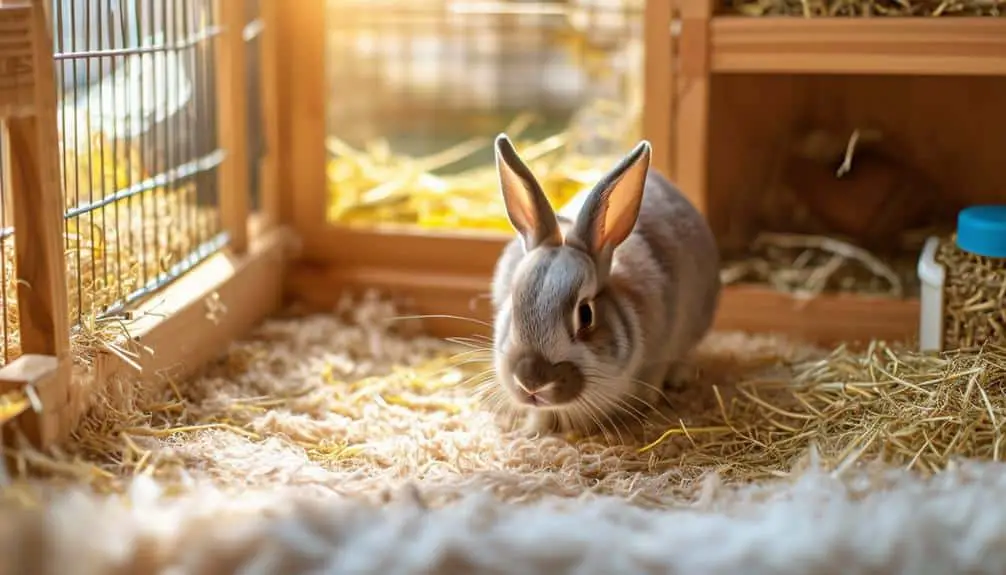
When contemplating appropriate housing for your pet rabbit, it’s important to make sure the space is spacious, secure, and designed to cater to their specific needs for eating, resting, and litter use. We need to prioritize a habitat that maximizes their well-being.
Unlike guinea pigs, rabbits require a larger area to hop around, so the enclosure should be roomy enough to facilitate natural behaviors. A solid flooring is important to prevent discomfort and injury, and the cage must be easy to clean to maintain hygiene.
Placing the rabbit’s home in a quiet area away from direct sunlight and household hazards ensures they remain safe and secure. Temperature control is crucial; avoid drafts and extreme temperatures to prevent health issues.
Enrichment is another critical aspect of rabbit housing. Incorporating items such as toys, tunnels, and digging boxes from Rabbit Supply can greatly enhance their mental stimulation and overall happiness.
Nutritious Diet
In addition to guaranteeing a secure and enriching habitat, we must make sure our pet rabbits receive a nutritious diet to support their health and vitality. A well-balanced diet is critical for their dental health, digestive function, and overall well-being.
Here’s what we need to include:
- Timothy Hay: Make sure to provide unlimited high-quality timothy hay. It’s essential for maintaining their dental health by naturally wearing down their continuously growing teeth. It also supports the best digestion and prevents gastrointestinal stasis.
- Fresh Vegetables: Incorporate fresh vegetables into their diet, focusing on leafy greens, carrots, and herbs. These provide essential nutrients and hydration. Introduce new vegetables gradually to monitor for any adverse reactions.
- Pellets: Ensure that we offer pellets specifically formulated for rabbits. These should be given in moderation to prevent obesity. A measured quantity daily suffices, typically around 1/4 cup per 5 pounds of body weight.
- Occasional Treats: Treats should be limited and consist of rabbit-safe fruits or herbs. Overfeeding treats can lead to digestive issues and obesity. Use treats as a reward during training or bonding sessions.
Fresh Water Supply
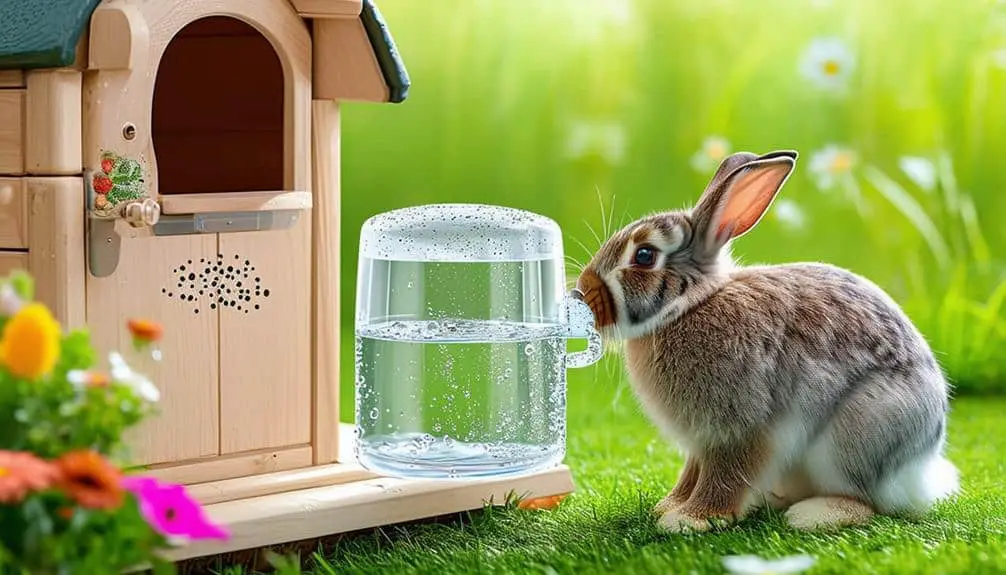
Ensuring our pet rabbits have constant access to fresh, clean water is essential for their hydration and overall health. Providing water through a water bottle is a practical and hygienic method, eliminating spills and minimizing contamination risks. We must guarantee the water bottle is securely attached to the enclosure to prevent tipping or leaks, which could restrict our rabbits’ access to this essential resource.
Regular water bottle maintenance and cleaning are necessary to prevent bacterial buildup. Clean the water bottle thoroughly at least once a week with warm water and a bottle brush. This practice ensures that our rabbits always have a fresh water supply, free from harmful pathogens.
Hydration monitoring is a key aspect of rabbit care. By keeping a close eye on their water consumption, we can detect early signs of health issues. A sudden drop in water intake might indicate underlying problems such as dental issues or gastrointestinal stasis. Adequate water consumption supports optimal digestion, temperature regulation, and overall vitality in our rabbits.
Understanding the importance of water consumption in rabbit behavior helps us provide the best care. Ensuring a constant supply of fresh water promotes their well-being and contributes to their freedom to explore and thrive.
Litter Box Setup
Creating an ideal litter box setup is crucial for maintaining hygiene and promoting proper waste management in our pet rabbits’ environment. Effective litter training starts with the right bedding options and strategic litter box placement. Let’s explore the key components of an ideal setup.
- Litter Box Location and Size:
Position at least two litter boxes in your rabbit’s living space to guarantee convenience and encourage consistent use. Choose boxes that are spacious enough for your rabbit to move comfortably, typically around 18×24 inches.
- Bedding Options:
Use rabbit-safe litter, such as paper-based or compressed wood pellets, to line the bottom of the litter box. These materials are excellent for absorption and odor control, thereby maintaining a clean and pleasant living environment.
- Encouraging Use:
Place hay near or inside the litter box. Rabbits enjoy munching while they eliminate, which reinforces litter box habits and aids in effective litter training.
- Maintenance Tips and Odor Control:
Regularly clean and maintain the litter box to prevent odors and ensure hygiene. Use a litter scoop for daily spot cleaning and completely replace the litter weekly. This routine will keep the environment sanitary and odor-free.
Enrichment Toys
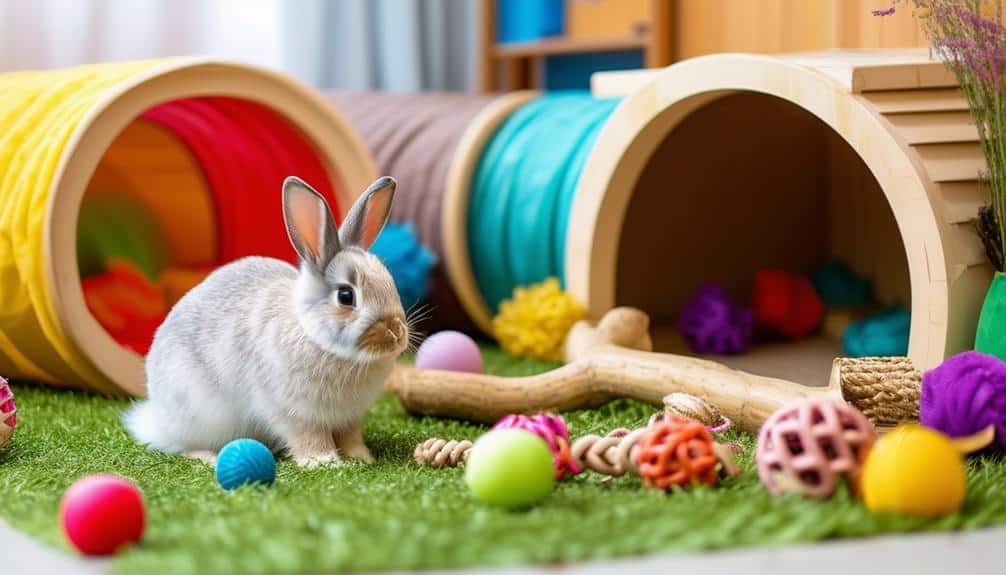
Rabbits frequently benefit from a diverse array of enrichment toys that stimulate their minds and encourage natural behaviors. These toys are vital for their mental stimulation and physical activity. Chew toys, puzzle feeders, tunnels, and balls can keep our rabbits engaged and prevent destructive behavior.
Interactive playtime is essential to prevent boredom. Treat-dispensing puzzles are excellent for this purpose—rabbits love the challenge and reward system, which mimics their natural foraging behavior. Providing a variety of textures, shapes, and sizes in toys can keep them interested and active.
Here’s a quick guide to some effective enrichment toys:
| Toy Type | Benefits | Examples |
|---|---|---|
| Chew Toys | Dental health, mental stimulation | Wooden sticks, hay blocks |
| Puzzle Feeders | Mental stimulation, foraging | Treat-dispensing balls, mats |
| Tunnels | Physical activity, exploration | Fabric tunnels, cardboard tubes |
| Balls | Interactive play, exercise | Plastic balls, willow balls |
| DIY Toy Ideas | Customization, cost-effective | Cardboard castles, toilet paper rolls |
Rotating these toys regularly can prevent habituation, keeping our rabbits consistently engaged. DIY toy ideas can be a cost-effective way to offer variety. By focusing on mental stimulation and interactive playtime, we can guarantee our rabbits lead enriched, happy lives.
Grooming Tools
When we discuss grooming tools, it’s important to focus on brushes and combs, nail clippers, and fur trimming tools as essential items.
Regular use of these tools can prevent fur matting, overgrown nails, and skin irritation, which are common issues in rabbits.
Brushes and Combs
Proper grooming tools, such as brushes and combs, are essential for maintaining your pet rabbit’s coat health and overall well-being. Regular brushing is important for preventing matting, controlling shedding, and promoting a healthy coat. Let’s explore the specific brush types and grooming techniques that can make a significant difference.
- Slicker Brush: Ideal for removing loose fur and minimizing shedding. It penetrates deep into the coat to guarantee thorough grooming.
- Comb: Excellent for detangling knots and mats. It’s particularly useful for rabbits with longer fur that tends to tangle.
- Grooming Mitt: This tool not only helps in coat maintenance but also allows us to bond with our rabbit, offering a gentle massage during grooming.
- Double-Sided Brush: One side for detangling and the other for smoothing the coat, making it a versatile addition to our grooming routine.
Using the right grooming tools ensures we maintain our rabbit’s coat health while also providing an opportunity to bond.
Grooming stimulates blood circulation, contributing to overall skin health. By incorporating these tools into a consistent grooming routine, we can enhance our pet’s well-being and keep their coat in excellent condition.
Nail Clippers
Maintaining your pet rabbit’s nail length with appropriate nail clippers is essential for preventing overgrowth and associated health issues. Regular trimming is vital for nail health, as overgrown nails can cause discomfort, affect posture, and even lead to injuries. To guarantee a safe and effective grooming process, we must use specially designed nail clippers for small animals. These clippers come in various types, sizes, and reputable brands, making it easy to find one that suits our rabbit’s needs.
Effective trimming techniques involve securing the rabbit comfortably, identifying the quick (the blood vessel inside the nail), and cutting just beyond it to avoid bleeding. Safety tips include using a gentle but firm hold, trimming in a well-lit area, and having styptic powder on hand in case of minor cuts. Consulting a veterinarian or professional groomer can provide additional guidance on proper techniques.
Establishing a consistent nail care schedule with trims every 4-6 weeks maximizes the benefits for our rabbit’s health and mobility. By adhering to this frequency, we ensure their nails remain at a manageable length, preventing potential health complications and enhancing their overall well-being.
Fur Trimming Tools
In addition to nail care, a thorough grooming routine for our pet rabbit requires the right fur trimming tools to maintain their coat health and hygiene. Regular grooming, especially during shedding season, is vital to prevent fur matting and other coat issues. By employing effective grooming techniques, we can guarantee our rabbit’s coat remains healthy and clean, while also preventing hairballs, which can pose serious health risks.
Here are four essential tools every rabbit owner should have:
- Slicker Brush:
Ideal for removing loose fur and preventing hairballs, slicker brushes penetrate the rabbit’s undercoat without causing discomfort. They’re particularly useful during shedding season when rabbits lose more fur.
- Grooming Wipes:
These are perfect for quick clean-ups and maintaining hygiene between baths. Grooming wipes help keep the coat fresh and can easily remove dirt and minor stains.
- Grooming Spray:
A grooming spray can help detangle fur and add a pleasant scent to the rabbit’s coat. It’s a handy tool for enhancing coat health and making brushing sessions more effective.
- Towels:
Soft, absorbent towels are essential for drying your rabbit after a bath or wiping off excess grooming spray. They also provide a comfortable surface during grooming sessions.
First Aid Kit
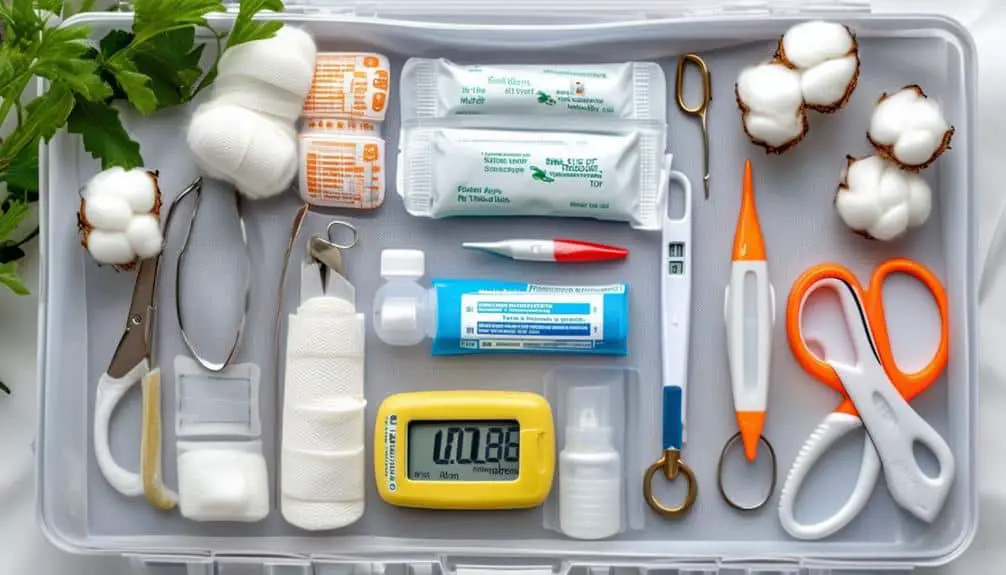
A rabbit first aid kit is vital for ensuring we’re prepared to address any health emergencies our pets might encounter. Having emergency supplies like styptic powder, nail clippers, and a thermometer readily available allows us to provide a quick response in critical situations. These items can help manage minor injuries and stabilize our rabbit until professional medical care is accessible.
Our first aid kit should also include gauze pads and saline solution for cleaning wounds, as well as critical care food to support our rabbit’s nutritional needs during recovery. A small pet carrier is essential for safe transportation to the vet, ensuring our rabbit remains secure and comfortable.
Regularly checking and replenishing the supplies in our rabbit’s first aid kit is important for maintaining its readiness. This proactive approach ensures we’re always prepared to address any sudden health issues, potentially saving our rabbit’s life in emergencies.
Conclusion
To sum up, ensuring our pet rabbits thrive requires essential components like suitable housing, a nutritious diet, and a consistent fresh water supply. A well-maintained litter box setup, engaging enrichment toys, and proper grooming tools are also vital.
To be fully prepared, we should have a first aid kit on hand. By adhering to these evidence-based recommendations, we can promote our rabbits’ health, well-being, and overall quality of life.
Let’s commit to providing the best care possible for our furry friends.

